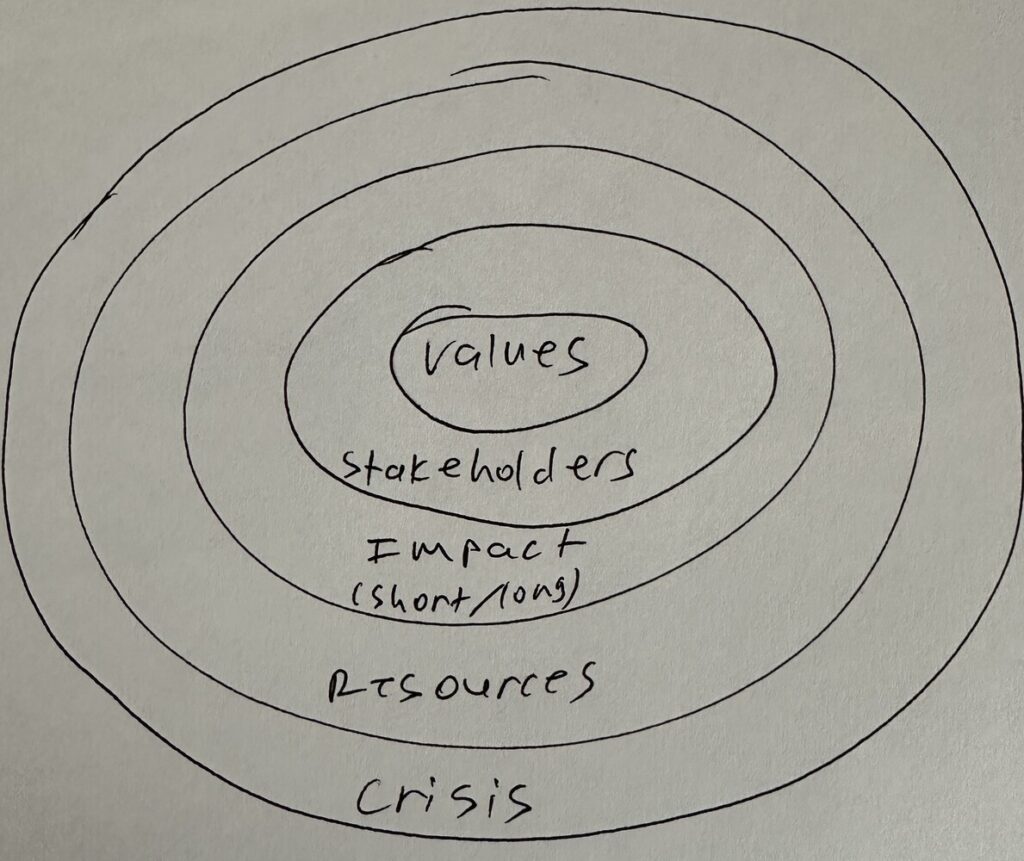This post first appeared for premium subscribers of Great Leadership on Substack and was published on June 16, 2023. If you want to get access to exclusive articles like this one and weekly 5 min leadership tips, then make sure to become a premium subscriber and get all of my best content and latest thinking delivered to your inbox. Learn more and sign up here. Premium subscribers get content like this every week.
…
Recently a big debate has been brewing in the business world when it comes to organizations investing in social causes or speaking up around controversial and polarizing topics. Specifically, what should they be investing in and saying and how should they decide?
A recent post published by the WSJ titled Companies That Embraced Social Issues Have Second Thoughts, highlights some of the challenges. One of the companies featured in that article is PPG a global paint supplier. I actually interviewed their former CEO and now executive chairman for a new book I have coming out called Leading With Vulnerability (more on that in the coming days.)
Their current CEO Tim Knavish is quoted in the article as saying:
“We run a business. We don’t run a political organization. We don’t run a religious organization, and we don’t run a social organization. “However, we recognize that we operate in a society. We hire employees with opinions and views. We work with customers that have opinions and views. So we have to take all that into account.”
In the article Tim says they use a scorecard to make these types of decisions.
In today’s polarizing business landscape executives are all trying to figure out what they should do and how they should do it. This is a trend that has been going on for a few years now and leaders are trying to play in the “grey area” for fear of upsetting people.
But the big fear that leaders should have isn’t that someone is going to disagree with them, it’s that customers and employees don’t know what the leaders and the company stand for to begin with!
No longer can leaders dwell in ambiguity or silence. They must assume a firm stance – either articulating their viewpoints, investing in causes, or explicitly choosing not to do so, with a rationale to support their decisions.
Below is a framework I’ve been working on that can help leaders decide if they should invest in a social cause or publicly discuss a polarizing topic.
I encourage you to use this as a template that you can build on top of.
I’ve been sharing this with a few leaders to get their perspectives and insights and it seems to resonate with everyone I’ve talked to. At the very least it makes for a good starting point that you and your organization can build on top of, perhaps by adding your own internal scorecard the way PPG has.
A quick disclaimer. The examples below are just that…examples, they are not meant to take sides, push topics, or make you angry. These are very real things that leaders needs to consider.
As I mentioned above, I think leaders need to take a stance (either for or against something) but there is a right and a wrong way to do so. Regardless of what you believe, it’s helpful to have a framework to know when and how to get into muddy water so that you and your business don’t drown.

Let’s start from the center
Values
The first question you should be asking is does the issue align with the values of the business? If not, then that’s a good sign that it doesn’t make sense for you to step foot into the arena. Whether you are looking at climate, transgender issues, gun control, abortion, vaccine mandates, politics, or any of the other land mine topics that are out there, ask if these are related to and aligned with the core values of the business. Bud Light which I will explore a bit below has the following 10 principles/values. Looking at their core values you can make the argument for both why they should and should not have gotten into the transgender arena. On the one hand they focus on diverse teams and inclusion but on the other hand they also focus on managing costs and making choices to drive growth.
Stakeholders
This includes your customers, your employees, and the broader related community. Ask if the issue is impacting your stakeholders in a significant way that is worthy of response. Bud Light is the recent example of this which was criticized heavily for stepping into the transgender debate which alienated most of their core stakeholders and cost the company over $27 billion in terms of lost sales and stock price drop, the VP of marketing was also fired. Looking at the the values about Bud Light did not align with their principle of making a choice to drive growth for the business clearly missing the fact that their new messaging was not aligned with their core consumer. After all Bud Light is a beer company and their core customer is a man who drinks beer.
…
Do you want more content like this that focuses on future-ready leaders, employees, and organizations? Join over 40,000 other people around the world who get my weekly newsletter filled with insights and strategies for how to become future-ready. Just enter your email here.
Impact (short/long)
What is the impact going to be to the business in both the short term and the long term? In 2017 Pepsi teamed up with Kendall Jenner on ads that were designed to promote peace and unity, certainly a noble cause right? However customers criticized the ad highlighting that it was trivializing an important issue and they didn’t feel the ads were authentic since Pepsi is viewed as a beverage company and not a social justice company. The backlash was so severe that Pepsi promptly issued an apology and pulled all of the ads within a few days. The negative impact here was short-term and today those ads are all but forgotten. The Bud Light impact however, is one that I expect to be both short term and long term. However, any business looking to get involved with social or controversial issues needs to have an understanding of the negative and positive impact to the business both short and long term.
Look at Nike and their 2018 “Just Do It” campaign featuring Colin Kaepernick, the NFL quarterback known for kneeling during the national anthem to protest racial injustice. The campaign was met with immediate controversy, leading to a short-term drop in stock price and some consumers even burning Nike products. However, Nike’s decision was in line with its brand values and its target audience’s beliefs, which largely consists of a younger, diverse demographic more likely to support athletes like Kaepernick and the causes they stand for. In the long run, the campaign not only recovered but also reportedly led to a significant increase in Nike’s sales and a boost to their brand’s reputation among their target audience.
Resources
Do you have the resources to make an investment or a contribution in a meaningful way? Resources doesn’t just include money but also time and people (which technically translates to money for most businesses). If your business is going to get involved in something does it have the resources to see it through? For example, when Salesforce didn’t like the policies of a state in the U.S. which they felt was targeting the gay and lesbian community they promptly said that they would cover all travel and moving expenses for employees who wanted to relocate and they canceled all of their large conferences and events in the area. A big and bold move that they were able to back up with the resources they needed to see it through.
Crisis
Do you have a plan of action for what to do if things don’t go according to plan? In 2015 Starbucks launched their Race Together campaign where baristas at over 12,000 locations were encouraged to write “race together” on all of the Starbucks cups handed out to customers. The campaign failed and was stopped within a week. The company was criticized for being a coffee company that had no place in race conversations, barista’s were not trained on how to have difficult race conversations, and many thought of the campaign as simply virtue signaling without making any meaningful contributions to racial inequality. After the campaign the then CEO Howard Schultz did the following:
-
Openly communicated the failure of the campaign both internally and externally. He talked about what they wanted to do, what they learned, and how they will do better.
-
Defended his intent of the campaign and why he did it but acknowledged it was poorly executed. He said he and his company would learn from their mistakes and they would stay committed to having difficult conversations in the future but in a more thoughtful way.
-
Made changes to their corporate culture and hiring policies aimed at hiring people from more diverse background and creating a more diverse leadership team.
-
Refocused on the core aspects of the business by providing great coffee to customers and positive environment.
Bud Light by the way quickly scrambled and promptly started investing in more “traditional” beer ads with Harley Davidson.
Summarizing the above framework yields to asking the following questions:
-
Does the issue align the core values of the organization?
-
Is the issue related to our stakeholders in a significant way?
-
Does it impact or touch a large portion of our stakeholders (customers, employees, community you serve)?
-
Is it relevant to our stakeholders? i.e. Do they want and expect you to get involved or do they just want you to focus on delivering the product and service they are accustomed to getting from you?
-
Do you know what the short term impact is going to be your business? Is it primarily positive or negative?
-
Do you know what the long-term impact is going to be your business? Is it primarily positive or negative?
-
Do you have the resources required to fully see this through?
-
If things don’t go the right way, do we have a crisis plan in place to mitigate any potential issues that may arise?
Asking the following questions and going through the above framework should be a great starting point for you and your organization to decide what social causes your company invests in or what polarizing topics your company wants to be a part of.
I’d love to hear from you, is what is your company doing and how is it thinking through these things?
…
Get access to more content like this by becoming a premium subscriber on Substack where each week you will get these types of articles delivered to your inbox along with other content.


